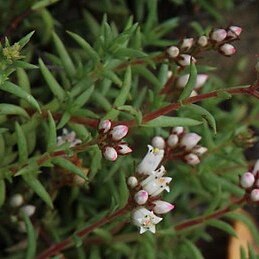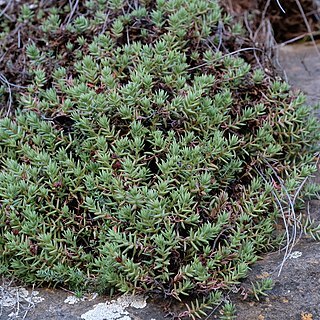Perennial herb. Stems decumbent or procumbent; old leaves drying, breaking off, leaving leaf sheath, but eventually stems also without remains of leaves, up to 0.2 m long; thin and wiry, covered with hair-like papillae, at least when young. Leaves fleshy; blade narrowly ovate to linear, 5-15 x 1-2 mm, apex sharply acute, dorsiventrally compressed, glabrous, green to brown. Flowers: in a ± flat-topped dichasium with few to many flowers; 5-merous; anthers brown; calyx lobes acute; corolla tubular, lobes narrowly ovate-oblong, 4-5 mm long, apices acute, dorsally ridged, recurved, white or cream-coloured; Dec.-Feb.
Perennial dwarf shrub, succulent, branched, decumbent, thin and wiry, ± 0.2 m high, papillae on young branches, rarely peeling bark on older branches, old leaves not deciduous. Leaves sessile, linear-lanceolate, 5-15 x 1-2 mm, acute, dorsiventrally flattened, glabrous, green to brown. Inflorescence an almost sessile, flat-topped dichasium, few to many flowers. Calyx: lobes of unequal length, ridged, fleshy glabrous, green tinged red. Corolla tubular, scarcely fused, white or cream-coloured; lobes lanceolate-oblong, 4-5 mm long, acute, dorsal ridge, recurved. Flowering time Dec.-Mar.
Perennial herb with decumbent branches, up to 200 mm long. Young branches usually covered with erect hairlike papillae. Leaves linear-lanceolate, 5-15(-20) x 1-2(-3) mm. Corolla with lobes lanceolate-oblong, recurved. Flowers white or cream.


